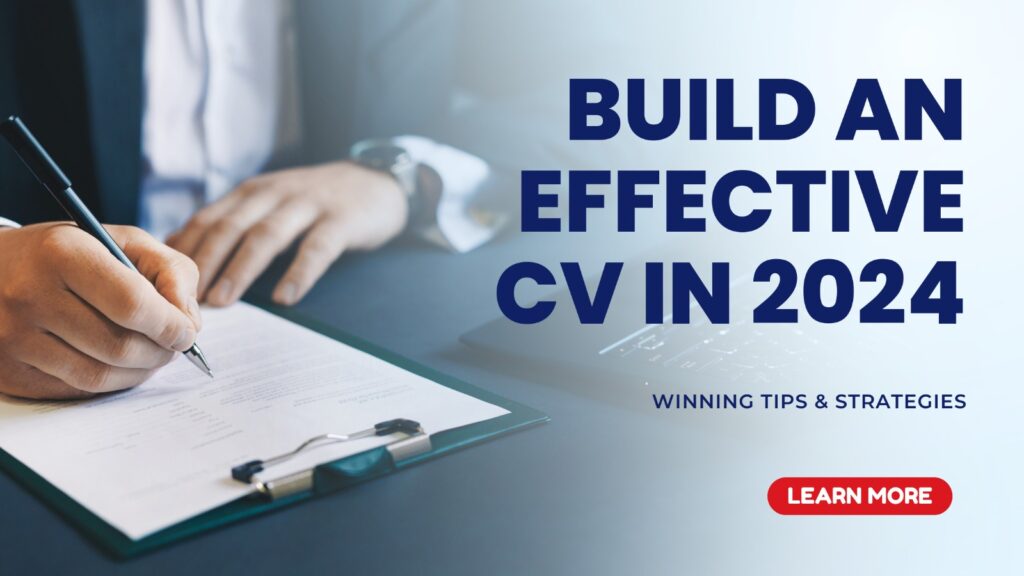In modern times, a well-crafted Curriculum Vitae or a CV is a ticket to land your dream job. Effective CV Building is not just a mere document but a comprehensive reflection of your qualifications and achievements during your professional experience. Many people ask how to build a CV? People also wonder what does CV stand for? CV or Curriculum Vitae is a tool that allows you to make a first impression by standing out from the crowd.
Effective CV format selection plays a crucial role in providing detailed information about yourself to the employer or the hiring managers to let them know that you are qualified for the job role you are applying for. An effective curriculum vitae creation typically includes information related to education, skills, and experience details related to your previous job experience. Professional curriculum vitae along with CV optimization for job applications if you present yourself professionally in the workplace. To know everything about Effective Curriculum Vitae Creation in 2024, make sure to read till the end!
Curriculum Vitae (CV) Writing Tips
Here are basic tips for writing a successful CV. These steps will help you build a good CV (Curriculum vitae) layout and design. Many students ask questions about ‘how to write a CV as a student’ or ‘how to make an effective CV’ and this structure is a complete guide to writing a perfect CV, either as a student or as an experienced professional. This structure will help you learn what should be added in your CV.
- Write a Header with Contact information: The first step is to include personal information such as your contact number, email ID, or any other source or link through which the hiring manager can reach you. A great CV typically includes your location, personal number, email ID, and LinkedIn ID.
- Provide a Professional Summary: A professional summary is a short bio, which is how you introduce yourself. This is typically two to three lines maximum. This includes your professional experience and your ideal career goal.
- Craft a Section of Education: This portion of the CV includes your educational background and most recent education at the top, followed by the details of your academic degrees and certificates.
- Develop a Timeline of Past Experiences: This is the most crucial step, especially if you are applying for a high-level post; you need to include this portion at the beginning of your CV. This portion consists of the following things. It includes part-time and full-time job positions, internships, research projects, lab work, publications, and volunteer work.
- Skills to Include: List your relevant skills, such as expertise in foreign languages or any type of software application. These skills are included in a successful CV that will make a person a more desirable candidate for a job post.
- List out Additional Sections: This section in a CV includes detailed information about your accomplishments. As a CV is longer than a resume typically, the list of additional sections to be added can consist of Conferences, Abroad experience, Awards and Honors, Publications, Community service or volunteer work, Grants or Fellowships, Memberships, and National and International Test Scores.
- Include Interests and hobbies (Optional): This CV section includes personal interests. Try to include a few hobbies that may help in connecting with the recruiter.
How to Design an Eye-Catching CV Layout and Design?
CV format selection should be wisely chosen. As recruiters or hiring managers have hundreds of CVs to skim on a daily basis, it is crucial for your CV layout and design to be easy to read and navigate. A CV should ideally take into account the following factors:
Pick a Clean and Professional Font:
Choosing a clean and straightforward font is easier to comprehend than decorative fonts, which, on the contrary, are distracting and very difficult to read.
Consistent Font Size and Style:
Maintaining font size and style consistency is essential to build an effective CV. Pick a style for CV layout and design, then stick to it. For headings, the font size should be slightly larger.
Clear Headings and Subheadings:
Organizing CV in headings and subheadings in a descriptive way. You can use fonts and highlight features to make them stand out from the rest of the content.
Use Headers and Footers:
Successful CV format selection includes a header at the top of the page, which includes bio-data such as the name and contact information of the employee. However, the footer at the end can indicate page numbers or any reference contacts if desired.
Avoid Unnecessary Icons or Symbols:
Consider incorporating icons or symbols to represent certain sections or skills, but use them sparingly and ensure they are relevant to your content.
Professional Photo (Optional):
Photo is optional in a CV; however, if you wish to include your picture, make sure it is a professional headshot with a clear background, and it should not take too much space in your well-crafted CV.
Usage of Bulleted Lists:
Bullets in the CV catch the attention of the employer directly. It enhances the readability of the CV by listing out achievements, certifications, or job experiences.
White Space and color variation:
Adequate white space gives a clean appearance to a CV, and it maintains a balance in the layout by avoiding cluttered visualization of your CV. And while most CVs are black and white, you can add subtle colors to it which can complement each other.
Consistency in Formatting:
Whatever section you are writing, the format of the whole CV should be consistent and appear neat and clean. For example, all the headings, job titles, and company names can be in one format to give a professional look.
File Format:
Most of the CVs submitted in today’s era are in digital form. Make sure the CV format selection is in PDF to preserve its format. PDF versions are mobile-friendly as well, which makes them more suitable for recruiters, so they do not face any readability problems. Even if the curriculum vitae (CV) must be submitted in hard form, make sure you use a standard paper size (e.g., A4) and the design is print-friendly.
Proofread, Edit, and Review:
Last but not least, it is very crucial for you to revise your CV (format selection and writing tips) a couple of times to make it completely free of all types of errors and typos. You can ask a friend to review your CV and get constructive feedback.
Tips to Make your CV Stand Out:
You have already read the CV writing tips and layout selection in the above paragraphs. But there are some other basic tips that you can use to make your CV the best CV.
- Keep it short and Concise: Make sure to keep your CV short but not too short. The CV should be one to two sides of paper. If you have too much information, summarize it and select the most relevant part. Furthermore, if it is shorter than a page, include more information about your skills, soft skills, and the responsibilities or experiences you have had in your previous jobs.
- Try to Use Active Verbs: Make sure to use as many active verbs as possible because active verbs make your CV look better. Use words like managed, created, developed, delivered, or provided about your past duties.
- Fill in the Gaps: Always avoid leaving any gap in your employment or professional history. Add every small employment detail that you have done.
- Up-to-date CV: Make sure that your CV is up to date. Do not use the same old CV for every new opportunity. Always add your recent experience in your CV.
- Optimize your CV: Optimize your CV for each role you are applying for because it makes you stand out from other applicants. It also leaves an impact that you have worked hard to achieve this opportunity.
- Never lie on your CV: Never lie on your CV about your experiences because the interviewer or selection committee can easily check your potential during the interview.
- Better CV Layout: Search for a good CV layout that is clear, easy to read, and pleasing to the eyes. Don’t use dark colors like red, purple, or others. Try to make your CV in subtle colors or combinations. Use bullet points to keep your points clear, short, and precise. Always take care of the spaces.
- CV Font Size: Try to use a Professional-looking or widely used CV font. It makes the readability and appearance of your CV better. The widely used font size for CVs is 12, and some of the best fonts for CVs are Arial, Calibri, Cambria, Georgia, and others.
- Check for Mistakes: Always check and proofread your CV to avoid any mistakes. Mistakes on a CV create a bad impression. Check your grammar and spelling, reread your CV, and ask someone to check it before you send it.
Writing a good CV can be difficult and time-consuming, but these tips to create a good CV can help you get the best possible start in your job search.
CV Optimization for Job Application (Applicant Tracking System):
Understanding how to use keywords for CV optimization for job applications is crucial for recruiters to find your CV and your chances of securing a job. As the Applicant tracking system, i.e., ATS is a software commonly used by recruiters, it is important to keep the following points in mind:
- Carefully try to understand and analyze the Job Posting and focus on the keywords and skills the employer asks for. This all is included in the job responsibility and qualification section.
- Identifying main or Core Keywords that are industry-specific and related to both hard (technical) skills and soft (communication, leadership) skills. Try incorporating these keywords naturally to avoid keyword stuffing, which can make your CV look spammy.
- Tailoring a CV according to a job application is a key to unlocking future success. Customize your CV by aligning what is more relevant and essential for the recruiter and try to match the organization’s requirements.
- Using relevant synonyms for keywords is also beneficial as ATS Systems easily recognizes them. For example, you can use project manager or administrator instead of project management.
- Use quantifiable data to demonstrate your highly relevant achievements and experience skills.
- Keyword Placement near the beginning of a well-designed CV is crucial as ATS systems generally prioritize the content at the top. It is a key to achieving CV optimization for job applications.
- Do not use acronyms without explanation. Try to spell the acronyms and then give their abbreviation in brackets, as ATS software may not recognize all acronyms.
- Testing your CV with ATS Tools is another important element in crafting a successful CV. Use ATS compatibility tools available online to see how your CV is drafted. These tools pinpoint the mistakes and suggest improvement regarding your CV.
These tools are necessary to keep in mind to enhance CV optimization for job applications. The applicant tracking system mentioned above includes tools without which a CV will not be ranked higher, so CV optimization for job applications is a must.
How to Write a CV? Online Tools and Resources:
There are plenty of web pages that offer online tools for the creation of Curriculum Vitae. This can help in the overall quality and look of building a CV. Some of the tools to improve your CV are mentioned below. Keep on reading to know how to build a CV for free.
CV Builders:
- Online platforms such as Zety, Canva, and Resume.io offer minimalistic and user-friendly templates and layouts for designing an effective CV. These platforms also offer free versions, which guide you through the process of creating a CV.
Building Free CV Templates:
- Free and customized CV templates that match your industry are available on websites like Microsoft Word, Google Docs, and Adobe Spark. You can select your layout and customize it according to your personal choice.
Grammar and Spell Checkers:
- To proofread your content, tools like Grammarly are great for your CV to be free of grammar, punctuation, and spelling errors. The tool also improves CV format selection through sentence structure and clarity.
Digital Networking (LinkedIn Profile):
- A professional platform like LinkedIn helps a lot in connecting with industry peers and employers. Optimizing a LinkedIn profile is extremely important as it is a digital representation of a curriculum vitae or CV. It is important to maintain your LinkedIn profile or portfolio and update it on a regular basis.
Online Communities and Forums:
- Try joining clubs and groups on Platforms like Reddit, Quora, and LinkedIn, where communities have been formed of professionals and people who are looking for jobs. You can discuss your CV writing tips and format selection with experts on these platforms according to market trends and get career advice. These forums are highly insightful.
Online CV Storage:
- Effective curriculum vitae should always be updated and stored in a place accessible from anywhere and anytime. Cloud storage services like Google Drive or Dropbox are easy to use and ensure you always have an updated copy of your curriculum vitae with you.
Following the guidelines and tools mentioned above can significantly help build a CV. Remember to always adopt the guidelines in the CV format selection according to your niche, industry requirements, and career goals. This guide will help you learn how to write an effective CV and hopefully you will have learned the top strategies by the end. Now you can also build an effective CV in 2024 and conquer your dreams.
Written by Adeena Tariq



